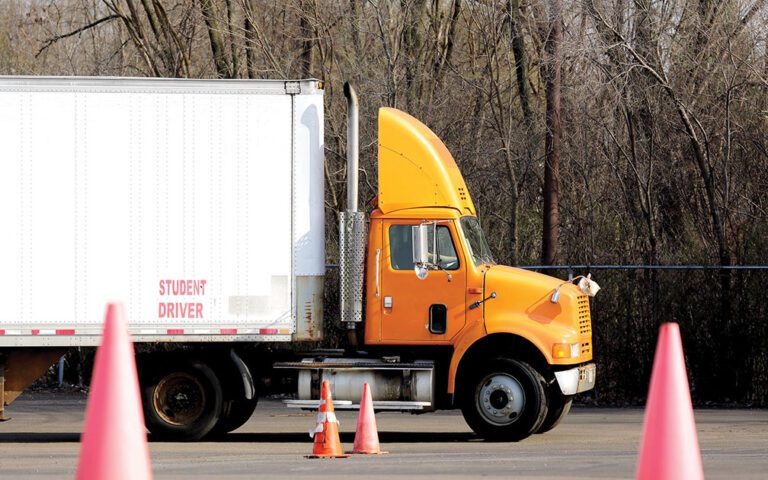It’s no secret that the trucking industry has a few issues when it comes to finding — and keeping — qualified, safe, and reliable drivers. Properly training new drivers is the first step; however, training regulations were somewhat murky until fairly recently.
The Entry-Level Driver Training (ELDT) final rule, which went into effect on February 7, 2022, finally brought some clarity to Federal Motor Carrier Safety Administration (FMCSA) input for training new drivers.
“It’s a good framework,” said Martin Garsee, a member of the FMCSA’s Entry-Level Driver Training Advisory Committee (ELDTAC), who helped craft the ruling. “It’s one of the best things we ever did.”
As director of transportation training at Houston Community College and executive director of the National Association of Publicly Funded Truck Driving Schools (NAPFTDS), Garsee knows a lot about driver training when it comes to what works and what doesn’t.
When the FMCSA published its previous Entry-Level Driver Training rule (380.503) in May 2004, it was primarily a paper exercise. The required training subjects were few. No minimum number of training hours or standards for a passing grade were specified. Notably, there was no required training for what might seem to be the most important subject — the operation of a commercial motor vehicle (CMV). A certificate went in the driver’s file for verification.
More importantly, carriers who wanted to verify the quality of training new recruits had received had few resources. A diploma might mean graduation from a college program or from a private school, ranging in training time from multiple weeks to a single day, often with corresponding quality. Some carriers were selective about which schools’ training they’d accept. Some required skills validation testing during orientation, and some simply trained their own drivers.
In addition to increasing public safety, the newest ELDT rules should help validate that the training received by new drivers is, at the very least, consistent. Training entities must register with the FMCSA’s Training Provider Registry (TPR), and they must self-certify that they meet the requirements. Individual instructors aren’t required to register unless they’re providing the training privately, outside of any organization.
CDL driver training now includes both theory and skills training in CMV operation, each requiring a certificate of successful completion to be on file in the TPR. Individual states must verify that the certificates are on file before administering written or skills CDL testing. Carriers can be more confident of the training received than in the past, but Garsee says he’d like to see a few improvements.
One of his concerns is the self-certification process for training providers.
“It’s a ‘self-certification,’ and today there’s no enforcement that people are actually doing the right thing,” he explained. “In my opinion, it’s caused a lot of people to get into the industry that were not before and really have no background. For example, here in Houston, there are several companies that expanded their teenage driver education to include CDL.”
An internet search for “one-day CDL training” reveals that those training providers with questionable certification haven’t gone away. Garsee believes a tweak to the self-certification requirement would help. Many states have agencies that oversee training schools, and some even issue licenses.
“A simple exercise of having to put your state license number on the self-certification form would help verify compliance,” he explained.
This is not the first time the FMCSA has needed time to develop an enforcement process after a rule went into effect; the current spate of electronic logging devices (ELDs) losing their certification is one example. These manufacturers self-certified that their products met FMCSA standards — but those devices fell short when enforcement actions began.
The lack of required training hours is also a concern for Garsee. Like many NAPFTDS member schools, Houston Community College followed a curriculum developed by the Professional Driver Training Institute (PDTI), which was allied with the Commercial Vehicle Training Association (CVTA) in 2020.
“I was more of an hours person,” Garsee said. “I would have preferred they left the hours in there. But you know, that wasn’t our fight. OMB (office of management and budget) took it out.”
The school’s curriculum hasn’t changed much, he noted.
“We’ve had to tweak a few things,” he said, adding that skills training, for example, focused on the specific skills that the state tested for. Some types of docking weren’t on the state CDL exam but are listed in the ELDT curriculum.
When the Truckload Authority team visited with North Little Rock, Arkansas-based Maverick Transportation, we found that entry-level training there hasn’t changed much either, according to Vice President of Safety and Driver Training Dean Newell.
“We were pretty much above the requirements before the new standards were put in place,” Newell said. “We seem to keep the academy full with what we want to have.”
Maverick isn’t the only driver trainer with full classes.
“We just finished our (NAPFTDS) conference in Asheville, North Carolina, two weeks ago, Garsee said. “Most of our schools are booked three and four months out.”
There’s good news about the aging driver demographic, too.
“We had a discussion about that at our conference, and most people are seeing their demographics change considerably,” Garsee remarked. “In our group, probably in the range of about 10 years or so younger.”
A part of the youth movement may be attributable to COVID-19, he said. As businesses shut down for the pandemic, trucking was very much in the public eye.
“I think the positive part of COVID has been that it brought a spotlight and renewed interest in trucking,” Garsee said.
At Maverick, Newell wants to keep the trend going.
“I believe we need to get to the potential drivers earlier in their career choices, i.e., high school job fairs etc.,” he said. “In reality, you can’t find enough electricians, plumbers, laborers of all types. They need to be educated on the fact that you can come out of the gate making a really good living and not be saddled with a bunch of debt.”
To reach those younger drivers, Maverick is turning more to social media, including Facebook, Twitter, and other, than in the past, receiving numerous leads from various platforms, according to Newell.
The latest ELDT rule may well be the right framework to improve training standards, once the bugs are worked out. The best schools were already following a curriculum that came close to or exceeded the new requirements, and those on the other end of the spectrum now have more guidance than ever before. In addition, the scenario of an owner-operator training a relative to drive still exists, with plenty of online training available for the theory portion of the required curriculum.
With more and younger drivers attracted to the trucking industry, the timing of improved training requirements couldn’t be better.
This article originally appeared in the May/June 2023 edition of Truckload Authority, the official publication of the Truckload Carriers Association.
Cliff Abbott is an experienced commercial vehicle driver and owner-operator who still holds a CDL in his home state of Alabama. In nearly 40 years in trucking, he’s been an instructor and trainer and has managed safety and recruiting operations for several carriers. Having never lost his love of the road, Cliff has written a book and hundreds of songs and has been writing for The Trucker for more than a decade.








